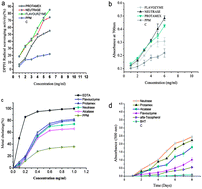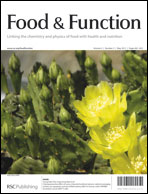Influence of enzymatic hydrolysis and enzyme type on the nutritional and antioxidant properties of pumpkin meal hydrolysates
Abstract
Nutritional and antioxidant properties of pumpkin meal and their hydrolysates prepared by hydrolysis with alcalase, flavourzyme, protamex or neutrase were evaluated. The hydrolysis process significantly increased protein content from 67.07% to 92.22%. All the essential amino acids met the Food and Agriculture Organization of United Nations/World Health Organization (WHO/FAO) suggested requirements for children and adults. The amino acid score (AAS) of meal was increased from 65.59 to 73.00 except for flavourzyme (62.97) and protamex (62.50). The Biological Value (BV) was increased from 53.18 to 83.44 except for protamex (40.97). However hydrolysis decreased the Essential Amino Acid/Total Amino Acid ratio (EAA/TAA) from 32.98% to 29.43%. Protein Efficiency Ratio (PER) was comparable to that of good quality protein (1.5) except for flavourzyme hydrolysate which had PER1 = 0.92, PER2 = 1.03, PER3 = 0.38. The in vitro protein digestibility (IVPD) increased from 71.32% to 77.96%. Antioxidant activity increased in a dose-dependent manner. At 10 mg mL−1, the hydrolysates had increased 1,1-diphenyl-2-picrylhydrazy (DPPH) radical scavenging activities from 21.89% to 85.27%, the reducing power increased from Abs700nm 0.21 to 0.48. Metal (Iron) chelating ability was improved from 30.50% to 80.03% at 1 mg mL−1. Hydrolysates also showed better capabilities to suppress or delay lipid peroxidation in a linoleic acid model system. Different proteases lead to different Degrees of Hydrolysis (DH), molecular weight (MW) distribution, amino acid composition and sequence, which influenced the nutritional properties and antioxidant activities of the hydrolysates. Alcalase was the most promising protease in production of pumpkin protein hydrolysates with improved nutritional quality, while flavourzyme was best in production of hydrolysates with improved antioxidative activity among various assays. These results showed that hydrolysates from by-products of pumpkin oil-processing might serve as alternative sources of dietary proteins with good nutritional quality, and protection against oxidative damage.


 Please wait while we load your content...
Please wait while we load your content...